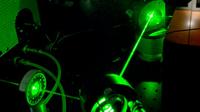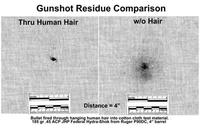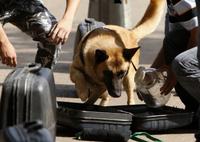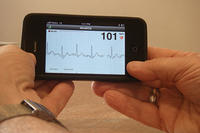-
Synthetic aperture sonar to help in hunting sea mines
Mines are plentiful and easy to make. Some mines explode on contact. Others are more sophisticated, exploding or deploying torpedoes when their sensors detect certain acoustic, magnetic or pressure triggers. Some can destroy a ship in 200 feet of water. Since the Second World War, sea mines have damaged or sunk four times more U.S. Navy ships than all other means of attack combined, according to a Navy report on mine warfare. New sonar research could improve the Navy’s ability to find sea mines deep under water. The underlying technology, known as synthetic aperture sonar (SAS), uses advanced computing and signal processing power to create fine-resolution images of the seafloor based on reflected sound waves.
-
-
Converting light to sound for better weapons detection, medical imaging
A device that essentially listens for light waves could help open up the last frontier of the electromagnetic spectrum — the terahertz range. So-called T-rays, which are light waves too long for human eyes to see, could help airport security guards find chemical and other weapons. They might let doctors image body tissues with less damage to healthy areas. They could also give astronomers new tools to study planets in other solar systems. Those are just a few possible applications.
-
-
Using light to detect trace amounts of explosives

Researchers may help in the fight against terrorism with the creation of a sensor that can detect tiny quantities of explosives with the use of light and special glass fibers. The researchers describe a novel optical fiber sensor which can detect explosives in concentrations as low as 6.3 ppm (parts per million). It requires an analysis time of only a few minutes.
-
-
New scanning technique may end on-board liquid restrictions
A new machine which can identify the chemical composition of liquids sealed within non-metallic containers without opening them is one of three candidates announced Monday to be in the running to win the U.K.’s premier engineering prize, the MacRobert Award. Already being deployed in sixty-five airports across Europe, this innovation can protect travelers by screening for liquid explosives and could spell the end of the ban on liquids in hand luggage.
-
-
Real-life CSI: The stories gunshot residue tell

The popular TV series “CSI” is fiction, but every day, real-life investigators and forensic scientists collect and analyze evidence to determine what happened at crime scenes. In a new study, scientists say they have developed a more rapid and accurate method that could allow crime scene investigators to tell what kind of ammunition was shot from a gun based on the residue it left behind.
-
-
How dogs detect explosives: New training recommendations

Researchers have helped determine the science behind how canines locate explosives such as Composition C-4 (a plastic explosive used by the U.S. military). The study found the dogs react best to the actual explosive, calling into question the use of products designed to mimic the odor of C-4 for training purposes.
-
-
Remote explosives detection may see the end of full-body scanners
Standing in a full-body scanner at an airport is not fun, and the process adds time and stress to a journey. It also raises privacy concerns. Researchers now report a more precise and direct method for using terahertz (THz) technology to detect explosives from greater distances. The advance could ultimately lead to detectors that survey a wider area of an airport without the need for full-body scanners.
-
-
DHS warns airlines of renewed shoe-bomb risk
DHS has alerted airlines flying to the United States to the possibility that terrorists might try to bring explosives n board in their shoes. The airlines were told that there were no specific plots, and that the information was based on information collected in the United States and abroad that bomb makers affiliated with terrorist groups were working on a shoe-bomb design. Hiding explosives in shoes is not new. In December 2001, passengers aboard an American Airlines flight from Paris to Miami prevented a U.K. citizen, Richard Reid, from detonating explosives hidden in his sneakers.
-
-
Small, portable, fast TLC unit for explosives, drugs analysis
Field Forensics of St. Petersburg, Florida, unveiled its microTLC, a portable and easy to use solution for pre-screening and presumptive identification of drugs and explosive mixtures. Thin layer chromatography (TLC) is an established laboratory procedure which identifies compounds belonging to the same general chemical class. The microTLC makes it possible for both laboratory and field analysis to be performed by first responders and forensics scientists.
-
-
Dolphin-inspired innovative radar system to detect surveillance, explosive devices
Inspired by the way dolphins hunt by using bubble nets, scientistshave developed a new kind of radar that can detect hidden surveillance equipment and explosives.The twin inverted pulse radar (TWIPR) is able to distinguish true targets, such as certain types of electronic circuits that may be used in explosive or espionage devices, from clutter (other metallic items like pipes, drinks cans, nails for example) that may be mistaken for a genuine target by traditional radar and metal detectors.
-
-
U.S. “bomb library” marks 10-year anniversary
It has been ten years since the FBI established the Terrorist Explosive Device Analytical Center (TEDAC), and since that time the multi-agency operation — sometimes referred to as America’s bomb library — has become an important tool in the nation’s fight against terrorism. Since its creation in 2003, TEDAC has examined more than 100,000 IEDs from around the world and currently receives submissions at the rate of 800 per month. Two million items have been processed for latent prints — half of them this year alone.
-
-
Lawmakers: Old plastic gun law has not kept pace with technology
The U.S. House of Representativesvoted last Tuesday to renew the 25-year old Undetectable Firearms Actwhich prohibits firearms that can evade metal detectors and X-ray machines. Law enforcement agencies say that developments in 3D printing make the law insufficient, and lawmakers who proposed amending the Act say that the only way to make such guns detectable is to require that at least one component of the firing mechanism in a plastic gun contain enough metal to be detectable in a magnetometer — and that that component be undetachable. The NRA opposes these requirements, saying that they would infringe on the Second Amendment rights of citizens.
-
-
Airport scanner vendor failed to disclose use of Chinese components
Recently TSA cancelled a $60 million contract with Rapiscan Systems, a manufacturer of anatomically revealing airport security scanners, after Rapiscan was found to be using unapproved Chinese components in its scanners – and failing to disclose this fact to TSA. Rapiscan, in bidding on the contract, submitted a list of U.S.-made components used in the scanners to the agency, as required by law. After the company received an approval of that list – and the $60 million contract – it ordered the same components from a Chinese company — the Shanghai Advanced Non-Destructive Testing – instructing the Chinese company to label the Chinese-made components with the same part numbers as the originally approved, U.S.-made components, apparently in an effort to make it more difficult for TSA inspectors to notice the illegal switch. Members of the House Homeland Security Committee, charging that the use of Chinese components made the machines susceptible to sabotage, disruption, or spying, want to know whether TSA was aware of Rapiscan’s shenanigans.
-
-
Airport screeners miss unusual – and possibly dangerous -- items

A smartphone app that turns gamers into airport baggage screeners is showing that finding weapons and other illegal items is not all that easy, even when you are looking for them. Researchers analyzed data from searches of twenty million virtual suitcases in the game Airport Scanner created by Kedlin Co. and found that users failed in most cases to identify objects that occurred only rarely. The reason: Commonly found objects may be crowding out identification of the unusual items.
-
-
Bottle scanning tech to enhance airport security, benefit passengers
Los Alamos scientists have advanced a Magnetic Resonance Imaging (MRI) technology that may provide a breakthrough for screening liquids at airport security. They have added low-power X-ray data to the mix, and as a result have unlocked a new detection technology. Funded in part by the DHS’s Science and Technology Directorate (S&T), the new system is named MagRay.
-
- All
- Regional
- Water
- Biometrics
- Borders/Immig
- Business
- Cybersecurity
- Detection
- Disasters
- Government
- Infrastructure
- International
- Public health
- Public Safety
- Communication interoperabillity
- Emergency services
- Emergency medical services
- Fire
- First response
- IEDs
- Law Enforcement
- Law Enforcement Technology
- Military technology
- Nonlethal weapons
- Nuclear weapons
- Personal protection equipment
- Police
- Notification /alert systems
- Situational awareness
- Weapons systems
- Sci-Tech
- Sector Reports
- Surveillance
- Transportation
Advertising & Marketing: advertise@newswirepubs.com
Editorial: editor@newswirepubs.com
General: info@newswirepubs.com
2010-2011 © News Wire Publications, LLC News Wire Publications, LLC
220 Old Country Road | Suite 200 | Mineola | New York | 11501
Permissions and Policies
Editorial: editor@newswirepubs.com
General: info@newswirepubs.com
2010-2011 © News Wire Publications, LLC News Wire Publications, LLC
220 Old Country Road | Suite 200 | Mineola | New York | 11501
Permissions and Policies
